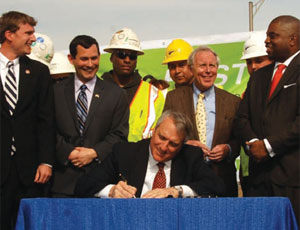In November 2008, the Colorado Dept. of Transportation released its assessment of the state’s transportation infrastructure, rating pavement surfaces on nearly half of the state’s highways, which total more than 3,000 miles, as “poor” or worse. Also, nearly 125 of the state’s bridges are in poor condition, with many of them labeled structurally deficient.

“With this bill, we’ll be able to begin work on the many unsafe bridges and roads all across this state — work that has been neglected for far too long,” Ritter said. “And at a time when the entire country is suffering from a recession, this legislation will let us save jobs, create jobs and help get our economy moving again.”
Many civil construction companies and their equipment, goods and service suppliers have laid off between 20% and 40% of their respective workforces in the last 18 to 24 months. The $330 million coming to CDOT for highway work from American Recovery & Reinvestment Act funds this year is a welcome relief, but only a temporary one that brings the state barely even with where it should be for this year’s highway needs.
“The money given to Colorado through the ARRA brings CDOT’s budget back to par, leaving everything at a wash and allowing the state to do the maintenance and construction projects it should be doing as planned,” said CDOT Chief Engineer Pam Hutton. “It won’t lead us to a larger T-REX-like project, but it will keep the state going.”
This year, CDOT experienced a cut in real dollars of more than $400 million from its 2008 budget, which means that with the stimulus money coming to the state—approximately $403 million in ARRA funds for road and bridge projects—Colorado is barely back to where it should be in comparison to 2008, Hutton said.
While FASTER represents an important step in the right direction, when fully implemented in three years, FASTER fee increases will annually generate about $250 million for road and bridge maintenance and transit infrastructure. In inflation-adjusted terms, that equals one-sixth of Colorado’s annual $1.5 billion need, according to Gov. Ritter’s Transportation Finance and Implementation Panel’s 2007 report.
“Even with FASTER, short of substantial new annually dedicated, inflation-adjusted funding, Colorado’s transportation infrastructure will continue to deteriorate at the rate of at least $500 million per year,” said Tony Milo, Colorado Contractors Association executive director. “Failure to address that deferred maintenance backlog soon will compromise road safety, undermine Colorado’s competitive edge in the region and cost Colorado’s taxpayers, transportation system users and economy more in future years.”

Post a comment to this article
Report Abusive Comment